Beware: Fake Binance Mining Pool Scam Returns
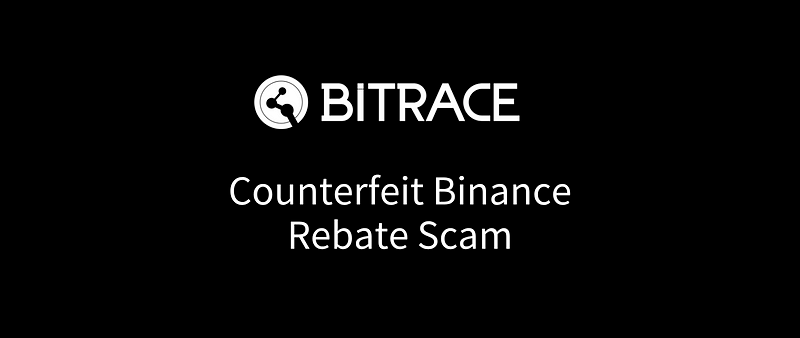
New investors are flooding into the cryptocurrency market with the desire for wealth growth, and this group of “new blood in the industry” has unfortunately become the new target of old scams. The fake Binance mining pool scam of “Deposit ETH and get back BNB” is back. This scam uses the banner of a well-known exchange and uses its platform Token BNB as bait to attract users to invest. It is very easy for novices to be deceived.
Since the beginning of 2024, Bitrace has received requests for help from more than ten victims of such scams, with a cumulative loss of nearly 2.12 million RMB (~300k), which shows its harm. Based on this, this article will dismantle the fake Binance mining pool scam from multiple angles, aiming to improve users’ investment identification capabilities and asset security awareness.
Fake Binance Pool Scam
Based on the information provided by the victims and how they were deceived, we will reproduce the scam below.
“Everyone gets rich” high imitation TG group
Like many scams begin, the fake Binance pool started with a TG group. The victim may have been introduced by a friend to join a “Binance Liquidity BNB Community” with about 50,000 members. The number of people online in the group is as high as 589. The group link is @Binance_chinesebnb (Binance’s official Chinese community is @BinanceChinese), with a black and yellow logo, which is difficult for newcomers to identify. In the group, scammers with different avatars pretending to be users are “talking”. One group is responsible for shouting about huge profits, while another group is pretending to be new and asking for advice. The victim who first arrived was blinded by the good show of “guaranteed profit and everyone getting rich”. Little did he know that everyone in the group except himself was a liar.

Project introduction includes payment tutorial
Driven by curiosity, the victim clicked on the “BNB Brick” fraud project introduction — the Binance Flash Exchange (ETH/BNB) smart chain contract will concentrate the ETH provided by the user into the ETH mining pool, and then through DeFi The protocol distributes ETH to users who need ETH. Each trade will generate roughly 0.2–1% profit, and the provided ETH will be returned to BNB in around 30 minutes.
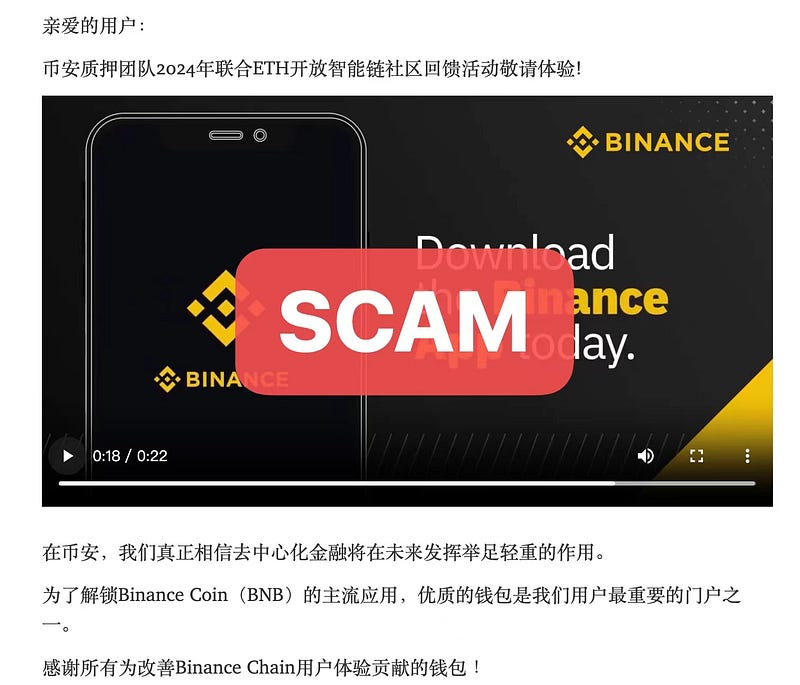
This is the fraud gang’s explanation of the source of the project’s profits. In order to give back to users, users can deposit ETH to provide liquidity through contracts to achieve intelligent interest generation and obtain BNB. This scam is based on the real economic incentive mechanism of liquidity mining in the cryptocurrency field, and steals Binance’s official promotional cover, popular science videos, BNB rights introduction and other content on the introduction page, and connects the fraud techniques with it, and even more It is confusing.
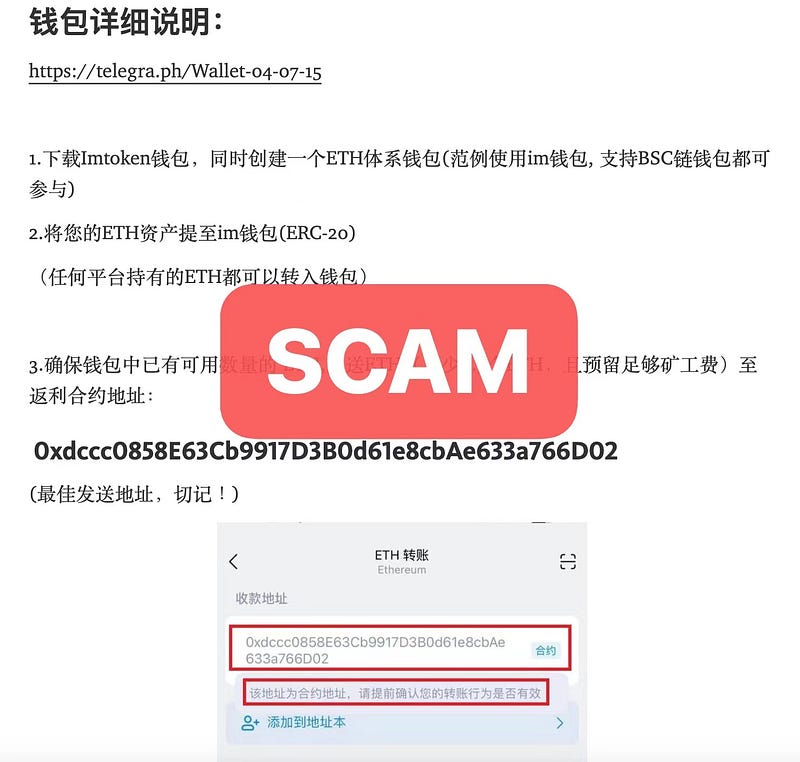
Another suspicious thing is that 70% of the content on the project introduction page involves investment tutorials. Since most of the scammers are novice users who don’t know how to operate on the chain, the scammers have launched extensive tutorials to ensure that the victim’s “investment” process is smooth — downloading wallets, registering for exchanges, purchasing ETH, and withdrawing ETH. And transfer money to the smart contract for liquidity mining and selling BNB. The scammers didn’t even bother to create a staking webpage, and directly induced users to make payments to the fraudulent contract address in the project introduction, with their intentions clearly revealed.
24h customer service
By comparing the official Chinese group of Binance with the fake community discussed in this article, it can be seen that the former has blue label certification and issued a warning against the fake community, saying that “anyone who privately chats with you is a liar.” On the other hand, the fake community is equipped with 24-hour online customer service to guide newcomers at any time on the “difficulties” encountered in operation.
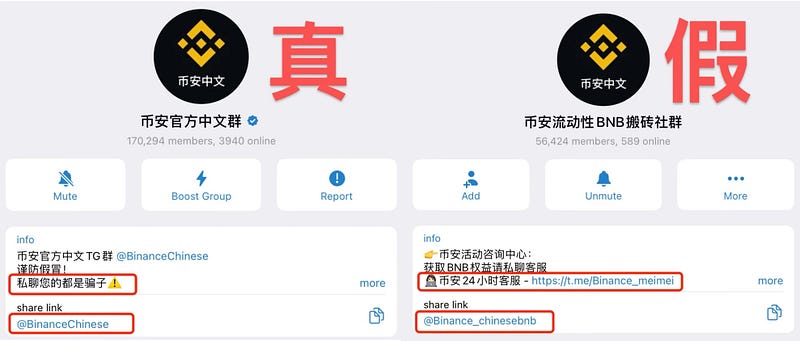
Under the guidance of customer service, the victim made a small payment with a trial mentality, and indeed received the corresponding BNB in return. After initially enjoying the benefits, he increased his investment in the hope of obtaining more income through circular arbitrage, but in the end his funds were stolen. Ended by cheating.
Real case analysis
According to the information provided by the victims, the amount of damage caused by the fake Binance mining pool scam is mostly between 1ETH and 20ETH, and the victims are mainly novices. Bitrace analyzed the addresses of multiple cases and found that the fund laundering methods in each case were relatively different, and there was little connection between the suspect addresses. The “Deposit ETH and Return BNB” scam seems to have several different fraud groups operating independently. They regularly update the crime addresses, and their propaganda and fraud techniques are almost the same as those mentioned above. It can be seen that this scam has formed a complete industry chain.
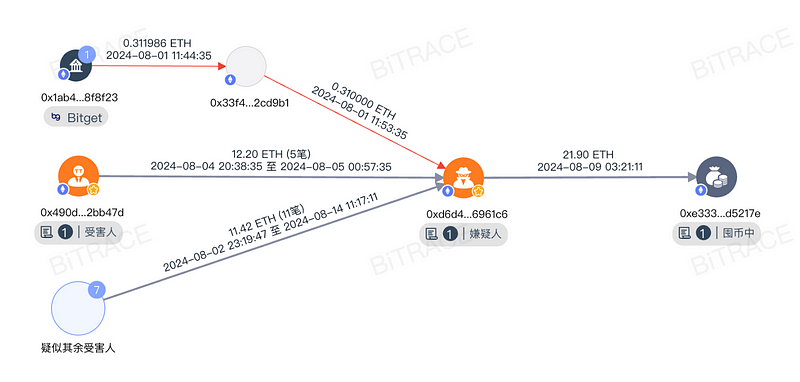
Taking the address of one of the victims as an example to analyze, we found that the suspect address 0xd6…61c6 has received a total of 16 payments from 8 victims since it was activated on August 1, totaling 23.62 ETH, worth approximately 44 Ten thousand yuan. By tracking the source of the handling fee of 0xd6…61c6, we found that it is related to an exchange. Currently, the stolen money is still being hoarded on the chain. Bitrace has assisted the victim in monitoring the movement of relevant addresses and guided the victim to report the crime.
How to spot scam
Here are Bitrace’s recommendations:
1. Find the official website. For any groups or social media channels, please look for the official certification mark.
2. Official entrance. Most of the official activities will have a special interactive entrance in the APP, and will never induce users to directly transfer money to the address for investment only through text.
3. Confirm with multiple parties. Confirm the authenticity of investment activities through cross-comparison through multiple channels, and do not blindly trust any activity links only published in the TG group.
4.KYT. Do a KYT investigation before making a cryptocurrency transfer, conduct a fund audit on the counterparty’s payment address, and should not conduct transactions with addresses that have a history of interaction with risky entities.
Contact us:
Website: https://www.bitrace.io/
Email: bd@bitrace.io
Twitter: https://x.com/Bitrace_team